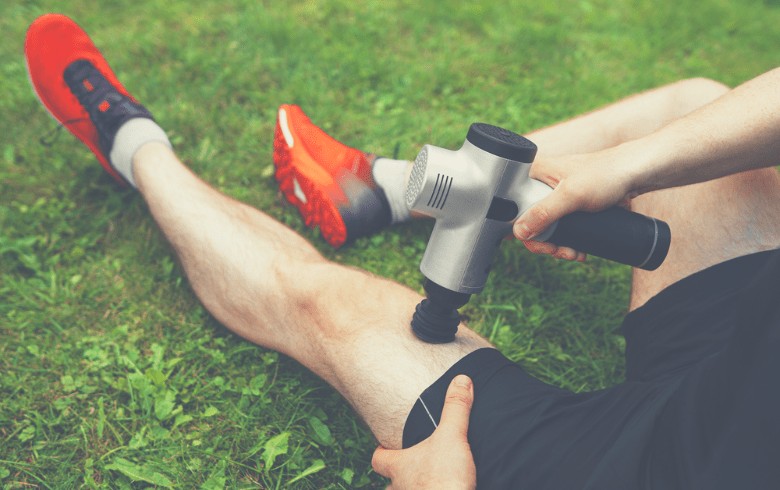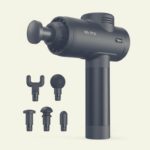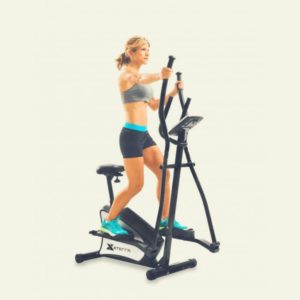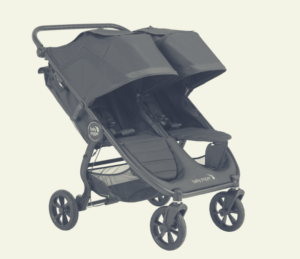The benefits of massages aren’t just limited to the relaxed feeling you experience. Massage has long been a preferred method to boost circulation, reduce soreness from exercise, amongst other benefits.
There are a wide variety of types of massage, and percussive therapy seems to be growing in popularity, but it begs the question…
What is Percussive Therapy?
Percussive therapy is a type of massage that uses a rapid and strong pulse in lieu of a kneading or vibration motion.
This is achieved by utilizing a massage gun, and while the massage gun was designed for home and rehab use, it is now growing in popularity with masseuses.
Why?
This device can get really deep into the muscles in a way that you can’t mimic with a traditional massage.
The massage gun’s drumming motion helps to stimulate blood flow to the area.
In turn, it can alleviate pain and soreness, keep your muscles working well, and is a much more cost-effective option to monthly massage sessions, but it doesn’t stop there.
What are the Benefits of Percussive Therapy?

Increases Circulation
Percussive massage flushes out venous blood and lymph fluid from your muscles.
This results in improved circulation can address numbness tingling from circulation-related issues as well as reduce swelling. As an added perk, it reinvigorates the muscles with much-needed nutrients.
Prevents Delayed Onset Muscle Soreness
Among the many benefits to your body is the ability to reduce the likelihood of what professionals call “delayed onset muscle soreness,” or DOMS.
If you find that you’re even sorer the second day after a hard workout, you’re experiencing delayed onset muscle soreness.
When you use a massage gun, and your body starts to increase blood flow to the area, it helps to minimize how sore you feel.
Even if a rough workout isn’t the cause of your pain, the massage gun is still able to alleviate soft tissue pain from a wide array of reasons.
Effectively Address Scar Tissue
The hammering motion of a massage gun can break up things like scar tissues and adhesions in a way that regular massage therapy can’t. It can also relax the fascia and connective tissues.
Gets Your Muscles Ready to Work
Aside from what percussive massage can do after a workout, it can also help prep your body for training.
When used as part of your warm-up, it gets the blood flowing to the areas you’re about to target, making for a more effective workout.
Relieves Tension and Stiffness
Regardless of whether you’re a workout newbie, couch potato, or hardcore athlete, this type of therapy can be beneficial.
It relieves tension in the muscles, elongates muscle fibers, and stretches the connective tissue, which can reduce stiffness, increase your range of motion and your flexibility.
Offers Relief for Symptoms of Fibromyalgia
Fibromyalgia is a painful disorder that affects muscles and joints and can cause a host of other issues that impact a person’s ability to live an active life.
Sciatica can cause pain down through the leg from hip to foot. It’s caused by the compression of the sciatic nerve, which is located in the lower back.
Percussive massage relaxes connective tissues, providing pain relief and quality of life.
Provides Powerful Contractions
The contractions caused by a massage gun are 30 times stronger than the contractions you may perform while you’re working out.
This can help strengthen your muscles, but it is highly beneficial for rehabilitation from injuries, surgeries, or even disease.
For example, percussive massage is regularly used on people who have paralysis to prevent atrophy.
Can Percussive Therapy Help with Weight Loss and Cellulite?
There’s been a lot of hype surrounding deep fascia massage and its ability to reduce cellulite’s appearance.
That said, because fascia is a connective tissue, it’s natural to wonder whether percussive massage can provide similar results.
Cellulite is a condition that creates little dimples in your skin, most commonly on your buttock and thighs, although it can appear anywhere.
It’s most common in women, but men can also suffer from cellulite, and it’s not only found in people who are significantly overweight.
When fat pushes up against the skin, it pulls down the tissue that connects the skin to the muscle, which results in cellulite.
You could be skinny but have fat buildup in certain areas that still lead to cellulite. Genetics also play their part in the likelihood that you’ll develop cellulite.
Massage guns can, in fact, help to address cellulite, but it’s critical to use the proper techniques.
As it improves circulation, it helps your fat cells to be distributed evenly, which helps to prevent fat from building up in those areas.
At the same time, if you already have cellulite, the percussive massager can also help to redistribute the fat cells pushing up against the connective tissue.
While you won’t be able to lose weight with a massage gun on its own, it can help to speed up your weight loss process.
Nutrients get pushed into the muscles better, and the strengthening of the muscles will help your metabolism.
Because it helps reduce soreness and the likelihood of injury, it also allows you to maximize your workout efforts.
So, it’s best used in addition to a healthy diet and consistent exercise regimen.
How Often Should I Use Percussive Therapy?
I mentioned earlier that technique is critical, but that’s not limited to use for cellulite reduction; it’s applicable to anytime you use a massage gun.
Part of using the correct technique is the frequency of use. Thankfully, your body is your best indicator.
While it’s important to use a percussive massager often in order to get results, more isn’t always better.
You can use your massage gun on a daily basis, even multiple times a day. However, you shouldn’t stay on one part of the body for longer than a couple of seconds at a time.
The best way to accomplish this is to use a rotating motion within a small circumference for a minute or two and then proceed to another small circle.
Some devices are intuitive and have automatic shut-offs after a short period of time. If your skin begins to redden, that’s a sign to move on, as that is a good indication that the blood flow to the area is significant.
Take stock of how you feel; if an area feels tender, then you’ve hit that muscle for too long.
The frequency of use is really dependent on what your goals are.
If you’re using a percussive massager to relieve and prevent sore muscles from a challenging workout, you should take five to ten minutes in your warm-up and cooldown to work the muscles you’re targeting that day along with the smaller surrounding muscles.
This is especially true for your cooldown period, as it will flush out toxins and lactic acid buildup.
For maximum results, you’d want to also do a quick session the day after your workout to send oxygen to your muscles.
On the other hand, if your goal is to minimize cellulite, it would be a good idea to utilize the gun two to three times a day for around 15 minutes per session.
For general stress relief, you can use the gun on areas where you have tension, which for most is their shoulders, for a few minutes twice a day, or whenever you feel anxious.

Where Can You Use Percussive Therapy?
Another vital piece of using the correct technique is understanding where you should and shouldn’t use a percussive massager.
All forms of massage are meant to focus on the muscles, not the nerves or joints. You want to stay away from bony areas like your knees and elbows.
Some devices have specialty attachments that allow you to get the benefits of percussive massage in your hands and feet.
While this is a great tool for addressing carpal tunnel, it’s essential to start very slow, listen to your body, and stay away from your knuckles.
A percussive massager should never be used on the neck, as this can even cause a carotid dissection which is a tear in your carotid artery that is especially dangerous.
You can, however, use the massager on the surrounding areas like your shoulders and back muscles.
You shouldn’t use this type of therapy on your spine or over any nerves.
If you feel a tingling sensation, that’s an indicator that you hit a nerve, and you should immediately move to another area.
While it probably goes without saying, you should stray away from anywhere you have bruises, injuries, rashes, trauma, cysts, or tumors.
Lastly, you should never use percussive massage on areas where you have impaired sensation.
In order to safely use this type of therapy, you need to have feedback from your body. Without this feedback, you won’t know if you’ve hit an area too long or a nerve.
Can Percussive Therapy Cause Damage?
When used correctly, percussive therapy is entirely safe. There are some risks associated with the incorrect use of a percussive massager.
For example, if you focus on one area for too long, there is the risk of bruising.
While this therapy is incredibly effective in reducing soreness associated with working out and can amp up the healing process, it certainly shouldn’t be used as an excuse to overtrain.
It’s common to think that a massage gun is an effective way to address pulled muscles, but this is not the case.
Using this type of therapy on pulled muscles or torn ligaments can result in further damage.
A percussive massage should never cause pain, regardless of whether it’s nerve pain, joint pain, or muscle pain; if you feel pain, stop immediately.
At best, the pain will negate the effects of the device, and at worst, you could cause significant damage.
A critical component to the safe use of percussive massage is to start slow on the lowest power setting.
Remember that the device should do all of the work, so there’s no need to press down on your muscles.
If you find that the lower power setting isn’t working, adjust your power settings conservatively, giving your body a few minutes before changing again.
Some people should not use percussive massage, including people who are currently on blood thinners like warfarin and heparin or if you tend to bleed and bruise easily.
Women who are pregnant, those who have recently had surgery, and those who intend to use this type of therapy for rehabilitation should always check with a doctor before starting therapy.
If in doubt, don’t roll the dice and speak with a medical professional.
Best Percussive Therapy Devices
| OPOVE M3 Pro Max massage gun | addsfit Max | Relxbit Pro Handheld Massager |
 |
 |
 |
| The OPOVE M3 Pro Max massage gun is very lightweight compared to most models, coming in at under 2.5 lbs. | The skin-friendly silicone material is what keeps the addsfit Max a step above the rest. | One of the things we like about the Relxbit Pro Handheld Massager is that it turns off after 10 minutes automatically to avoid muscle damage. |
 |
 |
 |
Wrapping Up
Percussive therapy is an excellent treatment for various conditions, but the benefits aren’t limited to fitness-related challenges.
It’s flexible in its use, making it an excellent investment for people who sit at a desk all day to relieve stress and improve your general health.
Percussive massagers are much cheaper than regular massage sessions that generally don’t hit the aspects of a percussive style massage.
You can reap the benefits based on your schedule. Devices are relatively small and can easily be thrown in a gym bag or suitcase if you’re on the go.
The cost of a device ranges from $80 – $600. However, it’s important to go with quality over quantity, and there are some great options in the middle of that range.
When you’re on the hunt for a massage gun, there are a few things that you should consider, including the grip style, types of attachment heads, noise level, and variety of power of settings.



